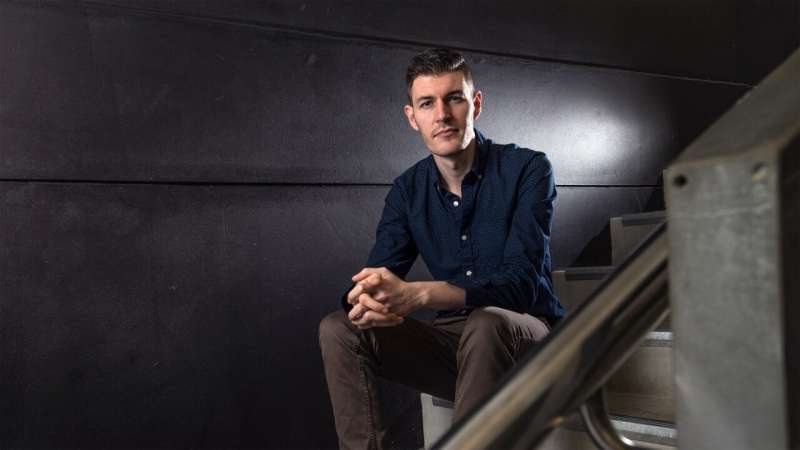Dr T.J. Thomson. Credit: Anthony Weate, QUT Marketing & Communication
Photographs tell a story beyond words. They can entertain, scandalise, educate and generate emotion. Billions of images are produced worldwide every day yet little is often known about how or why they were produced and by whom.
A new book by Dr. T.J. Thomson, visual communication lecturer in QUT's Creative Industries faculty, aims to step outside the narrow frame of the final image and look at the whole picture.
"Images can be a powerful tool to help people build and maintain identities, provide accountability and evidence, preserve fleeting moments and capture history," Dr. Thomson said.
"When used by the media, images can even topple a politician, alter the course of a war and help bring about significant social change."
To See and Be Seen: The Environments, Interactions and Identities behind News Images has just been published by Rowman & Littlefield International.
In it, Dr. Thomson dissects—primarily in a journalistic context—how visuals are the products of the locations, people, and interactions involved in their creation. He examines what it's like to be in front of a journalist's lens and how the dynamics between observer and observed affect the resulting depiction. He also explores how news subjects react to how they've been represented and what that means for the future of journalism.
"Issues of privacy, consent, and trust over visual representations span time, geography, culture, and ideology," said Dr. Thomson, who has previously worked as a photo editor for an international wire service and produced visuals for news organisations including The Washington Post, The Huffington Post, and The Associated Press.
"There are 3.2 billion images produced around the globe every day but we know little about their back story, despite the fact that humans use 75 per cent of the neurons in their brains to process visual stimuli.
"From a media law perspective, people generally enjoy freedom to document activity that occurs on public property. Consent and privacy concerns emerge when depictions with identifiable features are reproduced at scale for commercial or political purposes or to promote causes without the depicted individual's consent.
"In this age of social media, the concept of privacy is increasingly blurred. People pull out cameras to capture every moment of their life, as well as accidents, crimes and unfolding disasters, and often share this vision live or shortly after it was created.
"Time and time again, visuals play integral but mundane roles in individuals' everyday lives as well as shape society's course in grander ways."
To illustrate his points, Dr. Thomson includes case studies highlighting how people use online profile pictures for their social media identities and provides earlier examples of how now-famous photographs helped shape labour law reforms and civil rights advances.
He notes that 'iconic' images, like Steve McCurry's "Afghan Girl" or Dorothea Lange's "Migrant Mother" were accompanied by surprisingly few contextual details when they were first published and that these details, including names of the depicted and circumstances involving their representations, did not emerge until years later when retrospective interviews were conducted.
"We need a better informed news production process so that more interactive, trustworthy, and responsible depictions can occur," Dr. Thomson said.
Dr. Thomson's research is the result of hundreds of hours of observations and interviews with those who found themselves in front of a journalist's lens. His book synthesises insights from 68 visual journalists and photo editors in more than eight countries, 50 people who were featured in news coverage, analysis of more than 4,500 images, and observations from more than 100 events covered by visual journalists.
His findings suggest individuals who become subject matter for the news today expect to be treated with respect, as well as have their story acknowledged rather than just being treated as anonymous background material.
"People want interaction so they can determine the intent of the camera-wielding person, as well as what their motivations are and who they are affiliated with," he said.
"As social media become an increasingly dominant force in society, it is much easier for images to be shared without consent, or for photos to be re-fashioned beyond the initial purpose. A few public figures have learnt the hard way about the dangers of sexting, for example.
"Former New York Democratic congressman Anthony Weiner lost his job after sending an explicit selfie. Closer to home, Australian LNP MP Peter Dowling—the member for Redlands—stood down as chairman of Parliament's Ethics Committee after sending pornographic text messages."
Dr. Thomson added that by 2022, it's predicted 45 billion cameras will exist, which is around 5.625 for each of the earth's predicted eight billion inhabitants. One result of this is sacrificed privacy and a new relationship to the visual that he argues is increasingly critical to study.
More information:
To See and Be Seen: The Environments, Interactions and Identities behind News Images :
rowman.com/ISBN/9781786612816/ … s-Behind-News-Images
Provided by Queensland University of Technology






















